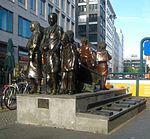Komische Oper Berlin
1892 establishments in GermanyArt Nouveau architecture in BerlinArt Nouveau theatresFellner & Helmer buildingsGerman opera companies ... and 6 more
Music in BerlinMusic venues completed in 1892Musical groups established in 1892Opera houses in GermanyTheatres completed in 1892Theatres in Berlin

The Komische Oper Berlin is a German opera company based in Berlin. The company produces opera, operetta and musicals. The opera house is located on Behrenstraße, just a few steps from Unter den Linden. Since 2004, the Komische Oper Berlin, along with the Berlin State Opera, the Deutsche Oper Berlin, the Berlin State Ballet, and the Bühnenservice Berlin (Stage and Costume Design), has been a member of the Berlin Opera Foundation.
Excerpt from the Wikipedia article Komische Oper Berlin (License: CC BY-SA 3.0, Authors, Images).Komische Oper Berlin
Behrenstraße, Berlin Mitte
Geographical coordinates (GPS) Address External links Nearby Places Show on map
Geographical coordinates (GPS)
| Latitude | Longitude |
|---|---|
| N 52.515833333333 ° | E 13.386944444444 ° |
Address
Komische Oper Berlin
Behrenstraße 55-57
10117 Berlin, Mitte
Germany
Open on Google Maps









